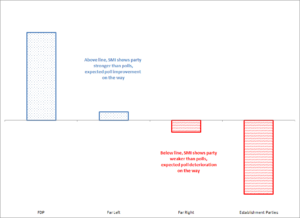Forecasting: 2017 German General Election
Difference between SMI and Poll Figures, parties further on the left of the chart have stronger SMI ratings than poll figures, for 2017 German General Election, ‘Establishment Parties’ include CDU and SPD and ‘Far Right’ includes AfD
Germany’s Election took on greater importance after Trump’s victory. People had already begun to question the validity of polls after the Brexit shock, but the unexpected US Election result made the situation look dire. Not only were polls not working as they had in the past, but anti-establishment often right-leaning politicians seemed to be benefiting. Many assumed Merkel, the long standing establishment centrist Chancellor, would be next to fall.
Germany had undergone its own domestic crisis in 2016. An unprecedented wave of immigrants from non-EU countries moved quickly into the EU, with many preferring Germany. One of the main reasons was the welcoming stance of Merkel. Many believed the domestic issues attempting to integrate such a large number of refugees would weaken her chances during the upcoming election. At the same time, a relatively new party, the AfD, or Alternative for Germany, was gaining quickly in the polls thanks partially to its stance against having open-ended refugee policies. By late 2016, betting markets placed the probability of the AfD’s candidate becoming the next Germany Chancellor at over 30%.
The AfD essentially winning the election would have a series of impacts but perhaps the most immediate would be on the Euro. Like most far right European parties, it is not very supportive of the Euro or its country’s full integration into an apparent United States of Europe (as supported by Germany’s main opposition candidate, Schulz, from the left-leaning SPD). In short, electing the AfD would throw 30+ years of Europe-wide integration into doubt. The markets believing the AfD had anywhere close to a real chance of winning the election was akin to a seismic shift. In January 2017, the Euro/USD was approaching parity, a level not seen since 2002 and one that many believed would never be tested again.
In this environment, Social Media Influence (SMI) picked up on very little early traction for AfD. In fact, the party was forecast to underperform polls and not greatly outperform them as markets had expected early in the race. SMI also pointed towards weakness for the two main establishment parties, but enough strength for Merkel to prevail. This scenario, which was in contrast to previous SMI calls for anti-establishment victories in the US and French elections, seemed slightly out of place in the then-current environment. However, during the course of 2017 up to election-day, German polls roughly followed the early indications of SMI with the once-feared AfD underperforming heightened market expectations and Merkel winning albeit in a weakened state.
Important because:
- SMI forecasted victory for the establishment candidate while many mainstream forecasters were sounding the alarm over populists,
- SMI’s early indication of weakness for the AfD proved extremely accurate, even more impressive given the consensus fear at that time,
- SMI’s early indication of weakness for establishment parties but enough strength for Merkel to win the Chancellorship also proved accurate,
- Showed that SMI does well in ‘normal’ elections and not just outlier type elections.
